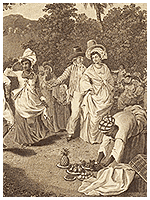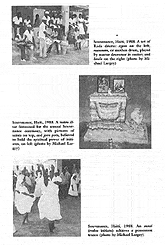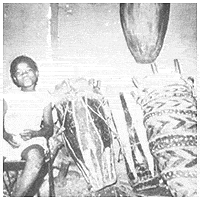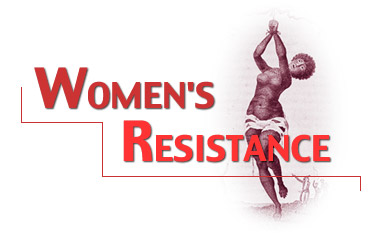Cultural identity is a fundamental part of personal identity because as human beings we are a sum total of our histories. History has taught us that we cannot advance without learning it; therefore it is an essential part of everyday life. When slaves were brought to the Caribbean, they were forced to leave everything they knew behind, their homes, their dignity and their culture, in other words, they were forced to leave behind themselves. Therefore, it became important to maintain traditions because tradition was the only way of keeping their cultural identity and helping slaves continue everyday life.
 Within the system of plantation slavery, outward expressions of culture were not accepted. Therefore oral tradition keeping became a vital way of keeping the past alive, focusing on the spirit and forging deeper bonds amongst slaves. In particular, religion and dance became a pivotal part of culture amongst slaves; ways for them to release emotions and offer up prayers to their gods. Slaves would gather whenever they had free time to engage in these ceremonies because, as Moreau de St.-Méry put it, "for them (slaves) the dance offers relaxation and, when they are not involved in the atrocities of fighting, they express themselves in a manner totally different from their warlike customs." This expression fascinated Moreau De St.-Méry. He was only vaguely aware of the origins of most dances, but in fact, most rituals within the slave Caribbean community originated in Africa. They took on modified forms in the Caribbean according to the secrecy of the event. One of the most successful of these modified, or "Creolized" forms is Vodou. Vodou is described as a spiritual experience because it is a ceremony primarily concerned with spiritual conversations with ancestors and the gods of Vodou. Practicing such a religion on the plantation became necessary for any slave to believe in a divine plan for their existence, and dance was a vital part of its ceremonies. "Through the medium of the dance, in pleasurable anticipation, the warrior could nourish his soul with feelings carrying him toward a glorious reward" . For slaves, religion and dance nourished their spirits as they headed towards freedom. Within the system of plantation slavery, outward expressions of culture were not accepted. Therefore oral tradition keeping became a vital way of keeping the past alive, focusing on the spirit and forging deeper bonds amongst slaves. In particular, religion and dance became a pivotal part of culture amongst slaves; ways for them to release emotions and offer up prayers to their gods. Slaves would gather whenever they had free time to engage in these ceremonies because, as Moreau de St.-Méry put it, "for them (slaves) the dance offers relaxation and, when they are not involved in the atrocities of fighting, they express themselves in a manner totally different from their warlike customs." This expression fascinated Moreau De St.-Méry. He was only vaguely aware of the origins of most dances, but in fact, most rituals within the slave Caribbean community originated in Africa. They took on modified forms in the Caribbean according to the secrecy of the event. One of the most successful of these modified, or "Creolized" forms is Vodou. Vodou is described as a spiritual experience because it is a ceremony primarily concerned with spiritual conversations with ancestors and the gods of Vodou. Practicing such a religion on the plantation became necessary for any slave to believe in a divine plan for their existence, and dance was a vital part of its ceremonies. "Through the medium of the dance, in pleasurable anticipation, the warrior could nourish his soul with feelings carrying him toward a glorious reward" . For slaves, religion and dance nourished their spirits as they headed towards freedom.
 When speaking of religion and dance, one must discuss the specific roles of women. Women were at the forefront of keeping traditions alive on the slave plantations. In many African traditions, women were guarded as an important part of society, mainly because it was believed that their ability to give birth gave them a special connection to the spirits. After slaves were brought to the Caribbean, it was important to raise children with traditional values because it was important for them to know where they came from, in order to know their history, in order to fill in the blanks about who they were. This is where women played an essential role. Since they were primary caretakers of children, they would be the first to instill values in them and therefore the ones who kept the traditions alive. In religious ceremonies, women would often be high priestesses and perform certain rites within a ceremony. When speaking of religion and dance, one must discuss the specific roles of women. Women were at the forefront of keeping traditions alive on the slave plantations. In many African traditions, women were guarded as an important part of society, mainly because it was believed that their ability to give birth gave them a special connection to the spirits. After slaves were brought to the Caribbean, it was important to raise children with traditional values because it was important for them to know where they came from, in order to know their history, in order to fill in the blanks about who they were. This is where women played an essential role. Since they were primary caretakers of children, they would be the first to instill values in them and therefore the ones who kept the traditions alive. In religious ceremonies, women would often be high priestesses and perform certain rites within a ceremony.
One of the many dances within the Vodou culture is the "Pétro". The Pétro was supposedly named in honor of Don Pedro, a rebellious slave in the French colony of St. Domingue. The Pétro thus was symbolic of the need to fight back against slave masters. Within Vodou traditions, the Pétro are the gods of aggression and anger. These gods were just what slaves need to raise up against their masters "because it caused great trouble and awakened ideas of violence contrary to public interest," as Moreau De St.-Méry described Don Pedro. According to him, in the Pétro dance, "the spectators, forming a kind of chorus, participate in the intoxication, and instead of becoming silent when the frenzy develops, they would redouble the volume of their songs, increase tempo, and aggravate the crisis in which they participate". Moreau goes on to describe the dancing associated with this rite as being "based on extremely vigorous movements of the head and shoulders, but to increase their violence the performers drink eau-de-vie which is mixed with finely pulverized gun powder. The effect of this drink combined with the vigorous movements has a great influence on the dancers, who enter into a kind of madness, with real convulsions."
 The beat of the music was also crucial to the way that dances developed. The rhythm guided the dancers with the beats of various instruments. Moreau De St.-Méry described these instruments and added that even if slaves were weary from a hard days work, they would not pass up the opportunity to participate in the ceremony. He illustrates the drums, which were made out of materials such as bamboo and lamb skin; the Calebasses, which had gravel within them and a long handle; the Banzas, a form of the banjo, a "primitive guitar with four strings"; and finally hand-clapping of the crowd. A chorus, sometimes of women, who chant and reply to each other, accompanied all of these. The beat of the music was also crucial to the way that dances developed. The rhythm guided the dancers with the beats of various instruments. Moreau De St.-Méry described these instruments and added that even if slaves were weary from a hard days work, they would not pass up the opportunity to participate in the ceremony. He illustrates the drums, which were made out of materials such as bamboo and lamb skin; the Calebasses, which had gravel within them and a long handle; the Banzas, a form of the banjo, a "primitive guitar with four strings"; and finally hand-clapping of the crowd. A chorus, sometimes of women, who chant and reply to each other, accompanied all of these.
"Until one has seen this dance he can hardly realize how vivacious it is-animated, metrical, and graceful". In Moreau De St.-Méry’s description of dance, he writes of it as if the dance were a female itself. He often mentions the passion one can feel for dance, and all its seductive qualities. Perhaps the only way that Moreau De St.-Méry could describe the delicacy of the dance was to describe it as having female qualities. He explained what he saw as the difference between European dances and the ones that he witnessed in the Caribbean. The two were both ceremonies of a sort of ritual but the slaves were "more vigorous dancers than are the colonizing Europeans of the same nationality."
 "Actually, anyone who feels an emotion strongly will express it by movements very similar to dance; and, if this joyful emotion is felt by several individuals, it is natural that hands and arms come together almost involuntary in a manner which links one to the other, and the movements mingle and are shared." If the metaphor of the body can be taken from what Moreau de St.-Méry said, we might see all body parts as being at the periphery of the heart. On the slave plantation, women were at the heart of what kept everything together until a single force, a union of many units. This legacy can be witnessed today in the way that many women are the stabilizing force in today’s families. Gerri Anderson wrote, "Africa is a stretch of the imagination. It’s the final link to the souls of our ancestors, and it is a spiritual awakening." Through birth, we are all born with a link to a history, then challenged to the life long task of making that history our own. Maintaining tradition through religion and dance are not only a way of holding on to tradition but also a way of paying respect to it. "Actually, anyone who feels an emotion strongly will express it by movements very similar to dance; and, if this joyful emotion is felt by several individuals, it is natural that hands and arms come together almost involuntary in a manner which links one to the other, and the movements mingle and are shared." If the metaphor of the body can be taken from what Moreau de St.-Méry said, we might see all body parts as being at the periphery of the heart. On the slave plantation, women were at the heart of what kept everything together until a single force, a union of many units. This legacy can be witnessed today in the way that many women are the stabilizing force in today’s families. Gerri Anderson wrote, "Africa is a stretch of the imagination. It’s the final link to the souls of our ancestors, and it is a spiritual awakening." Through birth, we are all born with a link to a history, then challenged to the life long task of making that history our own. Maintaining tradition through religion and dance are not only a way of holding on to tradition but also a way of paying respect to it.
|





